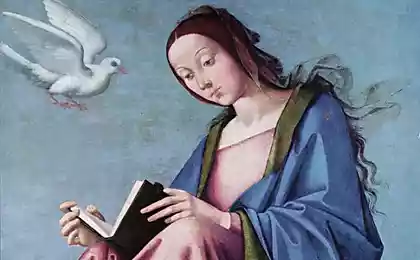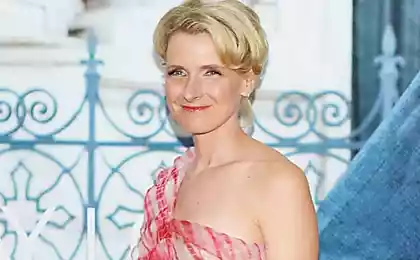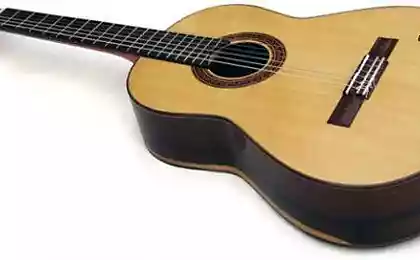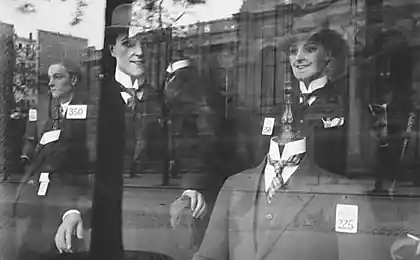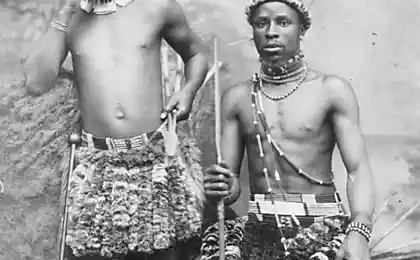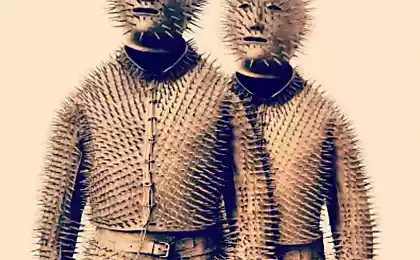1195
The genius of the XIX century and the creation of a giant
Look carefully at the ship. Built in 1858, it was able to deliver 4,000 passengers anywhere in the world and return to a port, without the need for refueling. Even today, it can only nuclear-powered ships, but this giant was built 100 years before them.
The Iron Giant monster cloud billowing white sails, and looming through a cloud of black smoke of hell, go ahead of his pipe - this luxury transatlantic liner, the miracle of the Victorian era was affectionately called "a great kid," his eccentric designer.
17 photos

10 years ago, the Air Force conducted a survey of people in the UK to identify the most 'great Britons in history. " The first place in the voting by a wide margin took Winston Churchill. But who took the second place? Maybe the great Virgin Queen Elizabeth I, King Henry VIII with his six wives, fearless Richard the Lionheart or Queen Victoria, the personification of an era? No. Then maybe Charles Darwin and Isaac Newton revolutionized science? Past. Admiral Nelson and the Duke of Wellington defeated Napoleon? Again, no. You might recall Shakespeare, John Lennon, and Princess Diana, but still can not guess the name.
Second place went to a modest engineer is hardly known outside of Britain. In England it is called the greatest genius of the Victorian era - "Leonardo da Vinci of the XIX century».
Victorian era (1837 - 1901 gg.) - A time when Britain was the greatest country in the world, never before or since has there been so huge state, whose territory covers all populated continents of the world. The greatest industrial power has the largest military and merchant fleet - the key that has allowed the de facto British rule half the world. This force was based on the most advanced technologies and the most advanced industry of the time. The Victorian era was the era of flaming copper, iron rattling, glittering steel, coal, the smoke and steam whistle. Then it seemed that engineering science is able to solve any problem and the technical problem, it is enough to choose and adapt to this steam engine.
The most remarkable of the Victorian engineers was a man of small stature, but with incredibly bold and big dreams. Meet - Isambard Kingdom Brunel. Some of his ideas ahead of time, some were almost crazy, but even his unsuccessful projects were more advanced than the most splendid achievements of its competitors. Contemporaries wrote about him: "He was the most active person in the business, the greatest artist of all ever worked with iron. He smoked 40 cigars a day and slept only 4 hours a day ».
The star of his genius rose to the height of fame of his father. Marc Brunel was a French engineer, construct buildings, factories, docks and piers in New York. In 1796, he even became chief engineer of the city in 27 years. It would seem that a good start, but Mark knows that the present turn his engineering abilities can only country in the world - the UK, and in 1799 he moved to England. The most famous creation Marc Brunel was the tunnel under the Thames. Construction began in early 1825.
His son Isambard Brunel, who then was only 18 years old, joined the project. Moreover, when his father was ill (as he often was ill), Isambard replaced him as chief engineer of the construction.
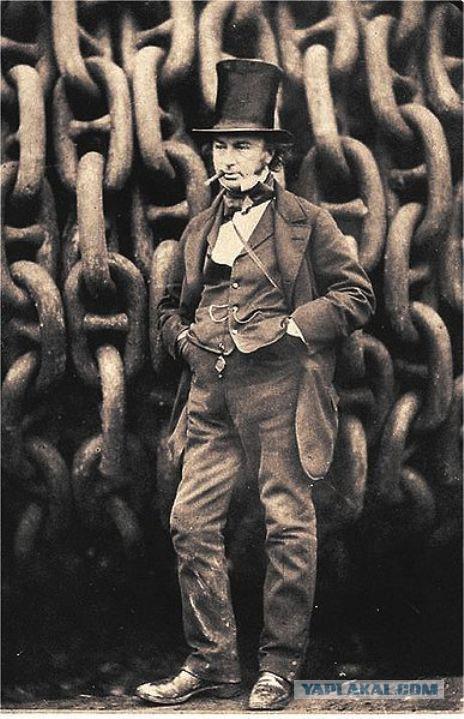
In 1828, disaster struck - a part of the wall of the tunnel collapsed, and a monstrous wave of muddy water rushed through the mine. The stream of water knocked Isambard and spun him by throwing stones at the only immediate response of his Hoosier helper, had time to grab Shorty Brunel and pull out of the whirlpool, saved him. He was never able to recover fully, injuries sustained during the accident, will haunt him all his life and perhaps serve the cause of his early death.
Brunel left the tunnel construction (it can hardly be reproached for it), and the project was completed without him in 1843. It was not a railway tunnel, as you might think, as a pedestrian, with the possibility of skipping cartage. Fantastic picture - stagecoach fare under the bottom of the river!
But by the time Brunel was captured by other projects - it builds bridges. One of his great creations became amazingly beautiful suspension bridge. The total bridge length of 230 meters, the length of the suspension span - 190 meters. It was then the longest suspension bridge span in the world. It builds bridges, one after another, but all of a sudden turns and throws a new idea that seemed to get him as no one else in the world.
He wants to build a "pneumatic passenger rail"! I remind the court of the first half of the XIX century, and our mad dreamer wants to build a train on the air drawn. Rumbling, puffing and fuming scary locomotives should replace low noise and clean trains and steam engines themselves will be the pumping stations along the route. It was launched into operation a 32-kilometer railway line is this. In this section of the train developed an incredibly huge for the time rate of 113 km / h! However, the idea proved too expensive and abandoned.
Let's try to briefly describe the achievements of Isambard Brunel. In the 19 years Isambard published its draft of the Panama Canal, which was implemented only in the XX century. He constantly developed new designs of engines and new types of weapons, projects of tunnels, canals. During his life Brunel constructed 25 railways in England, Ireland, Italy, India; under his leadership, and his project built eight piers, five suspension bridges, 125 railway bridges.
In 1833, 28-year-old Brunel commissioned the construction of the longest railway in England, from London to the west of the country to the port of Bristol. The road was called the Great Western Railway. All of its structures: bridges, viaducts, stations, tunnels are subject to a single concept, created as a single ensemble. This road was designed and built under his leadership, in just five and a half years. But our genius again, suddenly changing his profession - he decides to build ships! It was a time when the ships have only begun to explore the open sea and oceans. One of his first creations becomes the steamer Great Western, built in 1838. It was the largest wooden ship of its time. Many have said that it is too huge and unlikely to pay off its construction. But the ship was very modest by today's standards - just 72 meters in length. The skeptics were confounded, the ship became the first steamship, regular flights across the Atlantic in 13 days at the time unprecedented comfort for passengers.
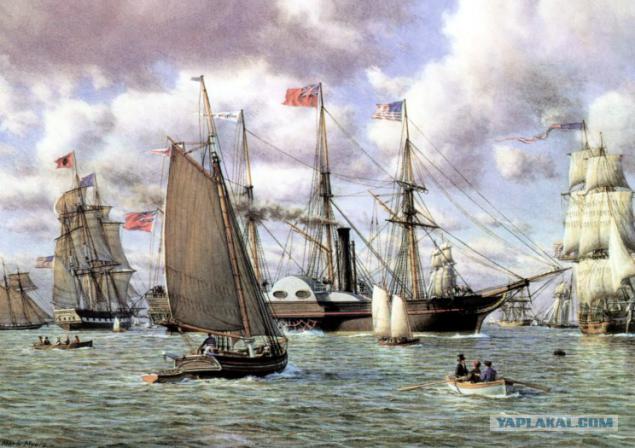
But these were only the first steps - it was built in 1845 by the ship Great Britney becomes truly revolutionary. When its construction was first used by the mass of new technical solutions, it was the world's first completely iron steamer, and the first large screw vessel and the first vessel, which was provided unsinkable, and much, much more. Great Britney was the biggest ship in the world, almost 100 meters long. He served faithfully for 46 years, is one of the flights has not been thrown on the rocks. In 1970 he was removed from the ship aground, restored and turned into a floating museum. He became a monument to the maritime history of the United Kingdom and the genius of its designer.
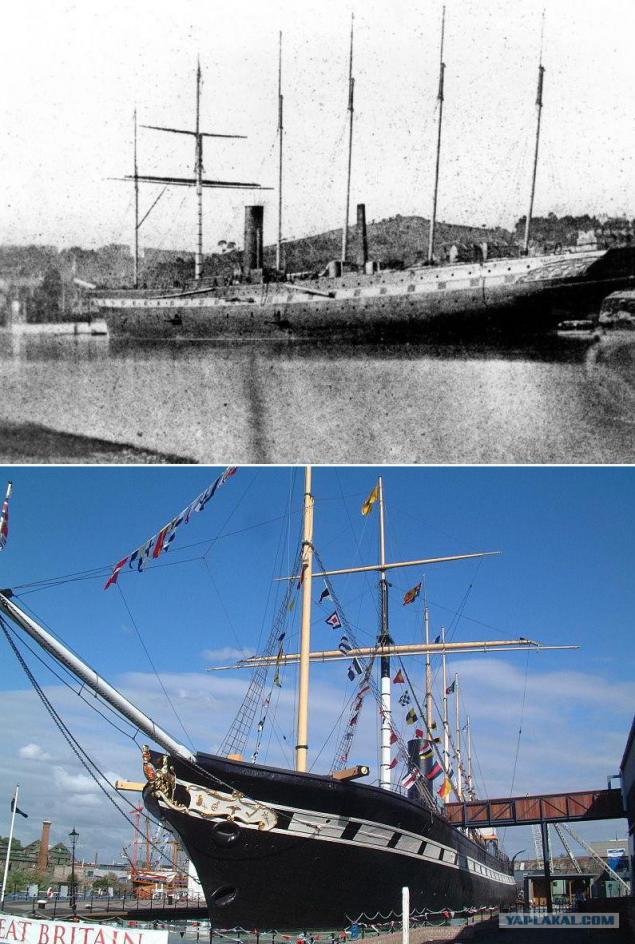
However, our story, and delayed in this article will not be able to talk about all the projects of Brunel's genius, so we move on to the most important of his brainchild.
In 1852, Isambard Brunel took to realize the most fantastic and the greatest of their great projects - the construction of the greatest ship of all time.

The name of the ship, invented by Brunel was Leviathan, after the huge Biblical monsters. It should be called exactly this monstrously huge ship the world has ever seen. The ship was supposed to be five times (!) More than any craft built before it.
The great ship was built in just three years. But in order to avoid the negative associations of the ship's name was changed to Great Eastern, after the company that built the ship (Eastern Steam Navigation Company). 211 meters long, with a displacement of 32 thousand. Tons - the ship is grand even by modern standards. For comparison - the famous Titanic was built half a century later, not much higher than its size - 246 meters long and with a displacement of 46 thousand. Tonnes. By comparison with the Titanic, we will come back again and again, and yet I tell you that cold numbers can not express the immense size of the ship. To get a better sense of their worth just look daguerreotypes and pictures taken during its construction below.
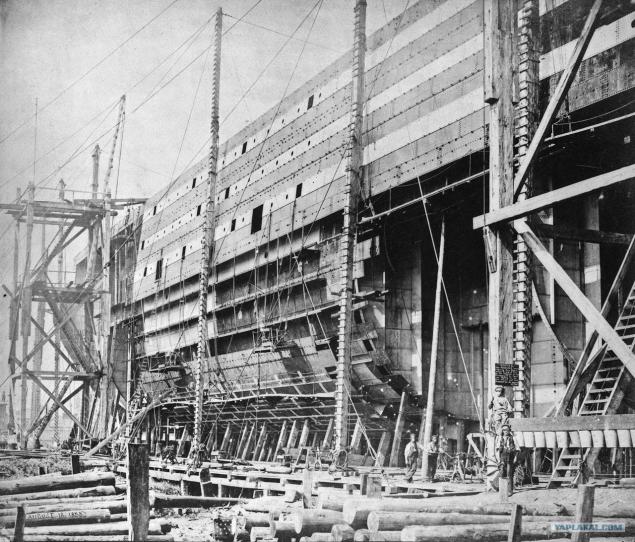
On stocks
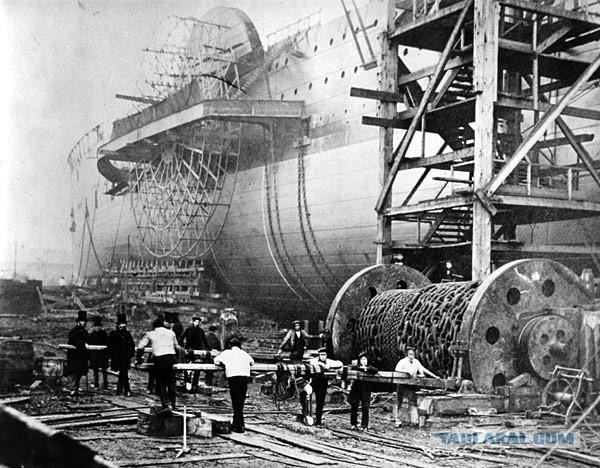
The heart of the ship were two steam engines, first developed unprecedented power in the 4 th. Horsepower rotating paddle wheel 17 meters in diameter (the height of a five-story building!), And a second machine with a capacity of 3600 hp led by a propeller diameter of seven and a half meters. Add to this the 10 boilers and 100 furnaces, which constantly throwing coal stokers. On the day this monster would eat 380 tons of coal, frantically puffing all five pipes.
But that's not all - the Great Eastern was carrying six enormous masts, complete rig which was almost two thousand square meters. Under the full-rigged, he could walk only with the engine off, otherwise the sparks from pipes just burned them. Masts called for days of the week - Monday, Tuesday, Wednesday, Thursday, Friday and Saturday. When Brunel, was asked why no mast Sunday, he said that in the sea there is no output.
The vessel had six auxiliary steam engines, one raised the unprecedented size anchors weighing 55 tons, other control winches for loading cargo, and a private car ran a huge wheel. For the first time on this ship was made and cargo-port - large opening at the bottom of the deck for loading railway wagons, carts with large stacks of cargo vans so that they themselves could enter the vehicle.
As a life-saving, it was decided to install on board two small screw steamer. The total number of boats were designed for the salvation of all people who were on the ship.
Boarding the vessel from 30 thousand. Iron sheet 22 mm thick and weighing 330 kg each holding 3 million. Rivets. In addition, the Great Eastern was the first vessel with double sides and bottom. Housing divided by ten watertight bulkheads that extend up to the upper deck. I note that on the Titanic, these bulkheads were significantly lower, which resulted in such rapid flooding of the ship.
The crew numbered only 400 people, but it was built so that the transport of passengers 4000 - the population of a small town! Titanic as 900 crew members carried only 2500 passengers. Great Eastern had every coal pits (15 thous. Tons of coal) to swim with the 4 th. Passengers to Australia and back without refueling. And all this in 1858!
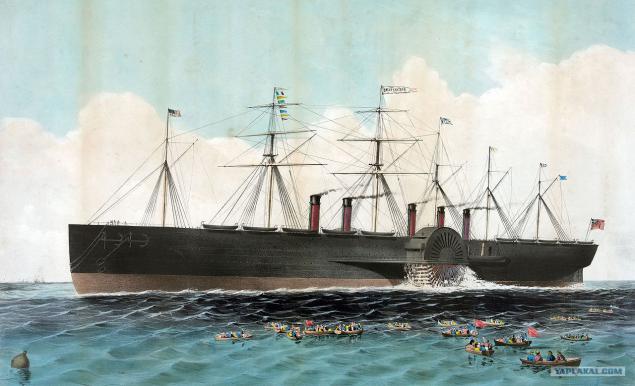
When you place your boat in an accident, jumped up winch killed two and injured three workers. Brunel suffered heavily this case. But the worst was yet to come - in September 1859 Great Eastern was released in its first test flight. Literally every other day on the ship blew up one of the boilers (as written in the "Times" - it was an act of sabotage) 6 people died and 9 were injured. When the news came to Brunel, his heart could not stand, and he died. The ship seemed to be under the influence of a rock, a little later during the transition to the boat from the ship to the port of Holyhead on the roads drowned captain and two passengers.
Accident and incident chased the ship - in 1862 it hit a submerged rock, but not drowned. The audience watched with interest over the misadventures of the ship, even taking bets on the date of his death. After a long renovation Great Eastern served only until 1867, and then embarked on an eternal trick. In 1888 it was sold for scrap, ship, construction of which cost more than 760 thousand. Pounds, was sold 30 years after only 8 years of operation, only 16 thousand. Dismantling giant lasted 18 months. And it turned out one of the mysteries of the ship. Between the two layers of the body (the gap between the two reached 1 m) was discovered two skeletons: adult (working-riveter) and boy-apprentice - dead even in the construction of the Great Eastern. One reason for the failures of the ship just call that "no matter where the ship sailed, he was carrying with him two corpses."

Today, the ship is sometimes called the biggest, most expensive, the most absurd and the most useless ship of the XIX century. Great Eastern has never made a transatlantic voyage at least one-third filled with passengers, and became, of course, absolutely unprofitable project. But in reality is not so simple, as any revolutionary technical design, created as soon as possible, he, along with many advantages possessed no fewer drawbacks. But the main flaw he had only one - it is ahead of his time, the era of great transatlantic liners come only after a half-century. Great Eastern just happened to be unclaimed.
Shortly before the completion of the Brunel invited to the ship of the famous historian of the Navy Lindsay. After touring Brunel Lindsay asked what his impressions.
- Well what can I say? This is the most durable and the perfect vessel from which I have ever seen. - Lindsay began.
- Excuse me - snapped Brunel - I'm not asking your opinion on its design ... You tell me something else: will pay for themselves whether my ship?
Lindsay tactfully silent. Then Brunel asked him directly:
- If the ship belonged to you, how would you use it?
- I would probably put it on the joke, it equipped the hotel with sea water bath, dance halls and made him first-class entertainment center for the Londoners, who would cut down on the thousands of boat.
Brunel was offended, but in fact Lindsay was right, and in recent years the Great Eastern was used as a floating circus and a huge billboard.
The sad history of the great ship, but comparing it difficult fate, the same Titanic, we understand that Brunel has created the ship is not just a reliable and ultra-reliable. Their fate in something similar and at the same time very different. Both were the biggest and most luxurious ship of its time. Both were in a similar accident - Great Eastern, a raid on an underwater rock, Titanic - an iceberg. But the results of the accident were completely different. Great Eastern was a huge hole nearly three meters wide and 25 meters long, but the inner body survived, and the ship was able to walk on their own to the port. Titanic, the latest data do not got a hole at all! The blow broke skin sheets and receiving a series of long thin cuts in six compartments that make up the area no more than a few square meters, superliner two and a half hours left at the bottom.
Let Great Eastern did not become a star of the transatlantic voyages, though set a speed record for crossing the Atlantic Ocean, but its amazingly bright contribution to the history of the industrial revolution he still did. When was the project of laying the transatlantic telegraph cable, it appears that the world is not able to lift cargo vessel thousand-durable shielded cable in addition to the Great Eastern. After several unsuccessful attempts (cable break) Great Eastern was able to accomplish this feat in 1866. For the first time succeeded in linking the two continents instantaneous telegraphic communication - the XIX century, it was an incredible breakthrough. It is now sitting at the computer, we will contact within seconds on an enormous distance, across oceans and continents. But the first time it became possible half a century ago by the great brainchild of Brunel. Total Great Eastern paved 50 thousand. Km transoceanic cables connected the first time to India, Europe and America.
Isambard Brunel was able to realize his dream of fabulous in no less astonishing reality. With these words I conclude the story of the difficult life of this talented, remarkably purposeful man and his wonderful creations, ahead of his time.

End of the glory of the great ship

Illustrations

Illustrations

Interior Great Eastern
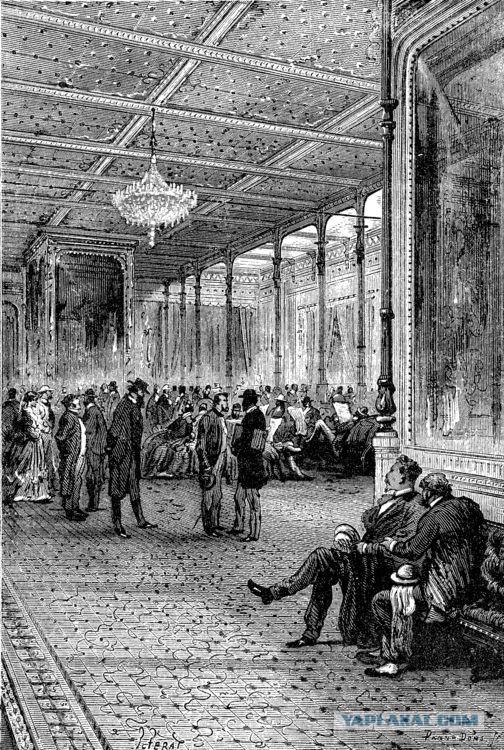
Souvenirs for passengers Great Eastern. Cigar card and mug

Yet let us remember it so - the zenith of glory and grandeur.
As the embodiment of the greatness of the human genius for whom nothing is impossible!
Posted in [mergetime] 1385424750 [/ mergetime]
Ufff ... That's all. I did not know how much was given the post in the subject line of that and does not have. Inexperience. At the time o the next predetermined.
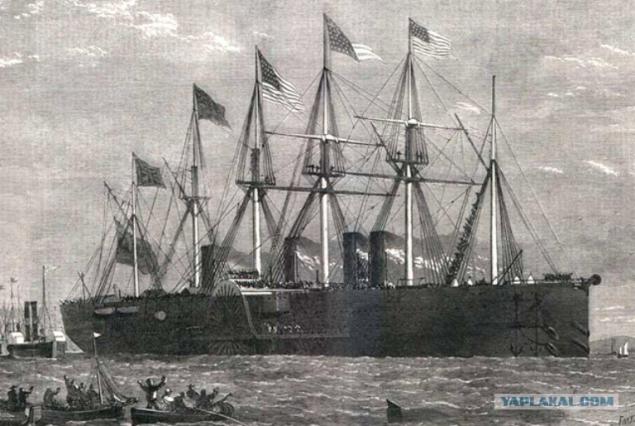
Source:
The Iron Giant monster cloud billowing white sails, and looming through a cloud of black smoke of hell, go ahead of his pipe - this luxury transatlantic liner, the miracle of the Victorian era was affectionately called "a great kid," his eccentric designer.
17 photos

10 years ago, the Air Force conducted a survey of people in the UK to identify the most 'great Britons in history. " The first place in the voting by a wide margin took Winston Churchill. But who took the second place? Maybe the great Virgin Queen Elizabeth I, King Henry VIII with his six wives, fearless Richard the Lionheart or Queen Victoria, the personification of an era? No. Then maybe Charles Darwin and Isaac Newton revolutionized science? Past. Admiral Nelson and the Duke of Wellington defeated Napoleon? Again, no. You might recall Shakespeare, John Lennon, and Princess Diana, but still can not guess the name.
Second place went to a modest engineer is hardly known outside of Britain. In England it is called the greatest genius of the Victorian era - "Leonardo da Vinci of the XIX century».
Victorian era (1837 - 1901 gg.) - A time when Britain was the greatest country in the world, never before or since has there been so huge state, whose territory covers all populated continents of the world. The greatest industrial power has the largest military and merchant fleet - the key that has allowed the de facto British rule half the world. This force was based on the most advanced technologies and the most advanced industry of the time. The Victorian era was the era of flaming copper, iron rattling, glittering steel, coal, the smoke and steam whistle. Then it seemed that engineering science is able to solve any problem and the technical problem, it is enough to choose and adapt to this steam engine.
The most remarkable of the Victorian engineers was a man of small stature, but with incredibly bold and big dreams. Meet - Isambard Kingdom Brunel. Some of his ideas ahead of time, some were almost crazy, but even his unsuccessful projects were more advanced than the most splendid achievements of its competitors. Contemporaries wrote about him: "He was the most active person in the business, the greatest artist of all ever worked with iron. He smoked 40 cigars a day and slept only 4 hours a day ».
The star of his genius rose to the height of fame of his father. Marc Brunel was a French engineer, construct buildings, factories, docks and piers in New York. In 1796, he even became chief engineer of the city in 27 years. It would seem that a good start, but Mark knows that the present turn his engineering abilities can only country in the world - the UK, and in 1799 he moved to England. The most famous creation Marc Brunel was the tunnel under the Thames. Construction began in early 1825.
His son Isambard Brunel, who then was only 18 years old, joined the project. Moreover, when his father was ill (as he often was ill), Isambard replaced him as chief engineer of the construction.

In 1828, disaster struck - a part of the wall of the tunnel collapsed, and a monstrous wave of muddy water rushed through the mine. The stream of water knocked Isambard and spun him by throwing stones at the only immediate response of his Hoosier helper, had time to grab Shorty Brunel and pull out of the whirlpool, saved him. He was never able to recover fully, injuries sustained during the accident, will haunt him all his life and perhaps serve the cause of his early death.
Brunel left the tunnel construction (it can hardly be reproached for it), and the project was completed without him in 1843. It was not a railway tunnel, as you might think, as a pedestrian, with the possibility of skipping cartage. Fantastic picture - stagecoach fare under the bottom of the river!
But by the time Brunel was captured by other projects - it builds bridges. One of his great creations became amazingly beautiful suspension bridge. The total bridge length of 230 meters, the length of the suspension span - 190 meters. It was then the longest suspension bridge span in the world. It builds bridges, one after another, but all of a sudden turns and throws a new idea that seemed to get him as no one else in the world.
He wants to build a "pneumatic passenger rail"! I remind the court of the first half of the XIX century, and our mad dreamer wants to build a train on the air drawn. Rumbling, puffing and fuming scary locomotives should replace low noise and clean trains and steam engines themselves will be the pumping stations along the route. It was launched into operation a 32-kilometer railway line is this. In this section of the train developed an incredibly huge for the time rate of 113 km / h! However, the idea proved too expensive and abandoned.
Let's try to briefly describe the achievements of Isambard Brunel. In the 19 years Isambard published its draft of the Panama Canal, which was implemented only in the XX century. He constantly developed new designs of engines and new types of weapons, projects of tunnels, canals. During his life Brunel constructed 25 railways in England, Ireland, Italy, India; under his leadership, and his project built eight piers, five suspension bridges, 125 railway bridges.
In 1833, 28-year-old Brunel commissioned the construction of the longest railway in England, from London to the west of the country to the port of Bristol. The road was called the Great Western Railway. All of its structures: bridges, viaducts, stations, tunnels are subject to a single concept, created as a single ensemble. This road was designed and built under his leadership, in just five and a half years. But our genius again, suddenly changing his profession - he decides to build ships! It was a time when the ships have only begun to explore the open sea and oceans. One of his first creations becomes the steamer Great Western, built in 1838. It was the largest wooden ship of its time. Many have said that it is too huge and unlikely to pay off its construction. But the ship was very modest by today's standards - just 72 meters in length. The skeptics were confounded, the ship became the first steamship, regular flights across the Atlantic in 13 days at the time unprecedented comfort for passengers.

But these were only the first steps - it was built in 1845 by the ship Great Britney becomes truly revolutionary. When its construction was first used by the mass of new technical solutions, it was the world's first completely iron steamer, and the first large screw vessel and the first vessel, which was provided unsinkable, and much, much more. Great Britney was the biggest ship in the world, almost 100 meters long. He served faithfully for 46 years, is one of the flights has not been thrown on the rocks. In 1970 he was removed from the ship aground, restored and turned into a floating museum. He became a monument to the maritime history of the United Kingdom and the genius of its designer.

However, our story, and delayed in this article will not be able to talk about all the projects of Brunel's genius, so we move on to the most important of his brainchild.
In 1852, Isambard Brunel took to realize the most fantastic and the greatest of their great projects - the construction of the greatest ship of all time.

The name of the ship, invented by Brunel was Leviathan, after the huge Biblical monsters. It should be called exactly this monstrously huge ship the world has ever seen. The ship was supposed to be five times (!) More than any craft built before it.
The great ship was built in just three years. But in order to avoid the negative associations of the ship's name was changed to Great Eastern, after the company that built the ship (Eastern Steam Navigation Company). 211 meters long, with a displacement of 32 thousand. Tons - the ship is grand even by modern standards. For comparison - the famous Titanic was built half a century later, not much higher than its size - 246 meters long and with a displacement of 46 thousand. Tonnes. By comparison with the Titanic, we will come back again and again, and yet I tell you that cold numbers can not express the immense size of the ship. To get a better sense of their worth just look daguerreotypes and pictures taken during its construction below.

On stocks

The heart of the ship were two steam engines, first developed unprecedented power in the 4 th. Horsepower rotating paddle wheel 17 meters in diameter (the height of a five-story building!), And a second machine with a capacity of 3600 hp led by a propeller diameter of seven and a half meters. Add to this the 10 boilers and 100 furnaces, which constantly throwing coal stokers. On the day this monster would eat 380 tons of coal, frantically puffing all five pipes.
But that's not all - the Great Eastern was carrying six enormous masts, complete rig which was almost two thousand square meters. Under the full-rigged, he could walk only with the engine off, otherwise the sparks from pipes just burned them. Masts called for days of the week - Monday, Tuesday, Wednesday, Thursday, Friday and Saturday. When Brunel, was asked why no mast Sunday, he said that in the sea there is no output.
The vessel had six auxiliary steam engines, one raised the unprecedented size anchors weighing 55 tons, other control winches for loading cargo, and a private car ran a huge wheel. For the first time on this ship was made and cargo-port - large opening at the bottom of the deck for loading railway wagons, carts with large stacks of cargo vans so that they themselves could enter the vehicle.
As a life-saving, it was decided to install on board two small screw steamer. The total number of boats were designed for the salvation of all people who were on the ship.
Boarding the vessel from 30 thousand. Iron sheet 22 mm thick and weighing 330 kg each holding 3 million. Rivets. In addition, the Great Eastern was the first vessel with double sides and bottom. Housing divided by ten watertight bulkheads that extend up to the upper deck. I note that on the Titanic, these bulkheads were significantly lower, which resulted in such rapid flooding of the ship.
The crew numbered only 400 people, but it was built so that the transport of passengers 4000 - the population of a small town! Titanic as 900 crew members carried only 2500 passengers. Great Eastern had every coal pits (15 thous. Tons of coal) to swim with the 4 th. Passengers to Australia and back without refueling. And all this in 1858!

When you place your boat in an accident, jumped up winch killed two and injured three workers. Brunel suffered heavily this case. But the worst was yet to come - in September 1859 Great Eastern was released in its first test flight. Literally every other day on the ship blew up one of the boilers (as written in the "Times" - it was an act of sabotage) 6 people died and 9 were injured. When the news came to Brunel, his heart could not stand, and he died. The ship seemed to be under the influence of a rock, a little later during the transition to the boat from the ship to the port of Holyhead on the roads drowned captain and two passengers.
Accident and incident chased the ship - in 1862 it hit a submerged rock, but not drowned. The audience watched with interest over the misadventures of the ship, even taking bets on the date of his death. After a long renovation Great Eastern served only until 1867, and then embarked on an eternal trick. In 1888 it was sold for scrap, ship, construction of which cost more than 760 thousand. Pounds, was sold 30 years after only 8 years of operation, only 16 thousand. Dismantling giant lasted 18 months. And it turned out one of the mysteries of the ship. Between the two layers of the body (the gap between the two reached 1 m) was discovered two skeletons: adult (working-riveter) and boy-apprentice - dead even in the construction of the Great Eastern. One reason for the failures of the ship just call that "no matter where the ship sailed, he was carrying with him two corpses."

Today, the ship is sometimes called the biggest, most expensive, the most absurd and the most useless ship of the XIX century. Great Eastern has never made a transatlantic voyage at least one-third filled with passengers, and became, of course, absolutely unprofitable project. But in reality is not so simple, as any revolutionary technical design, created as soon as possible, he, along with many advantages possessed no fewer drawbacks. But the main flaw he had only one - it is ahead of his time, the era of great transatlantic liners come only after a half-century. Great Eastern just happened to be unclaimed.
Shortly before the completion of the Brunel invited to the ship of the famous historian of the Navy Lindsay. After touring Brunel Lindsay asked what his impressions.
- Well what can I say? This is the most durable and the perfect vessel from which I have ever seen. - Lindsay began.
- Excuse me - snapped Brunel - I'm not asking your opinion on its design ... You tell me something else: will pay for themselves whether my ship?
Lindsay tactfully silent. Then Brunel asked him directly:
- If the ship belonged to you, how would you use it?
- I would probably put it on the joke, it equipped the hotel with sea water bath, dance halls and made him first-class entertainment center for the Londoners, who would cut down on the thousands of boat.
Brunel was offended, but in fact Lindsay was right, and in recent years the Great Eastern was used as a floating circus and a huge billboard.
The sad history of the great ship, but comparing it difficult fate, the same Titanic, we understand that Brunel has created the ship is not just a reliable and ultra-reliable. Their fate in something similar and at the same time very different. Both were the biggest and most luxurious ship of its time. Both were in a similar accident - Great Eastern, a raid on an underwater rock, Titanic - an iceberg. But the results of the accident were completely different. Great Eastern was a huge hole nearly three meters wide and 25 meters long, but the inner body survived, and the ship was able to walk on their own to the port. Titanic, the latest data do not got a hole at all! The blow broke skin sheets and receiving a series of long thin cuts in six compartments that make up the area no more than a few square meters, superliner two and a half hours left at the bottom.
Let Great Eastern did not become a star of the transatlantic voyages, though set a speed record for crossing the Atlantic Ocean, but its amazingly bright contribution to the history of the industrial revolution he still did. When was the project of laying the transatlantic telegraph cable, it appears that the world is not able to lift cargo vessel thousand-durable shielded cable in addition to the Great Eastern. After several unsuccessful attempts (cable break) Great Eastern was able to accomplish this feat in 1866. For the first time succeeded in linking the two continents instantaneous telegraphic communication - the XIX century, it was an incredible breakthrough. It is now sitting at the computer, we will contact within seconds on an enormous distance, across oceans and continents. But the first time it became possible half a century ago by the great brainchild of Brunel. Total Great Eastern paved 50 thousand. Km transoceanic cables connected the first time to India, Europe and America.
Isambard Brunel was able to realize his dream of fabulous in no less astonishing reality. With these words I conclude the story of the difficult life of this talented, remarkably purposeful man and his wonderful creations, ahead of his time.

End of the glory of the great ship

Illustrations

Illustrations

Interior Great Eastern

Souvenirs for passengers Great Eastern. Cigar card and mug

Yet let us remember it so - the zenith of glory and grandeur.
As the embodiment of the greatness of the human genius for whom nothing is impossible!
Posted in [mergetime] 1385424750 [/ mergetime]
Ufff ... That's all. I did not know how much was given the post in the subject line of that and does not have. Inexperience. At the time o the next predetermined.

Source:


